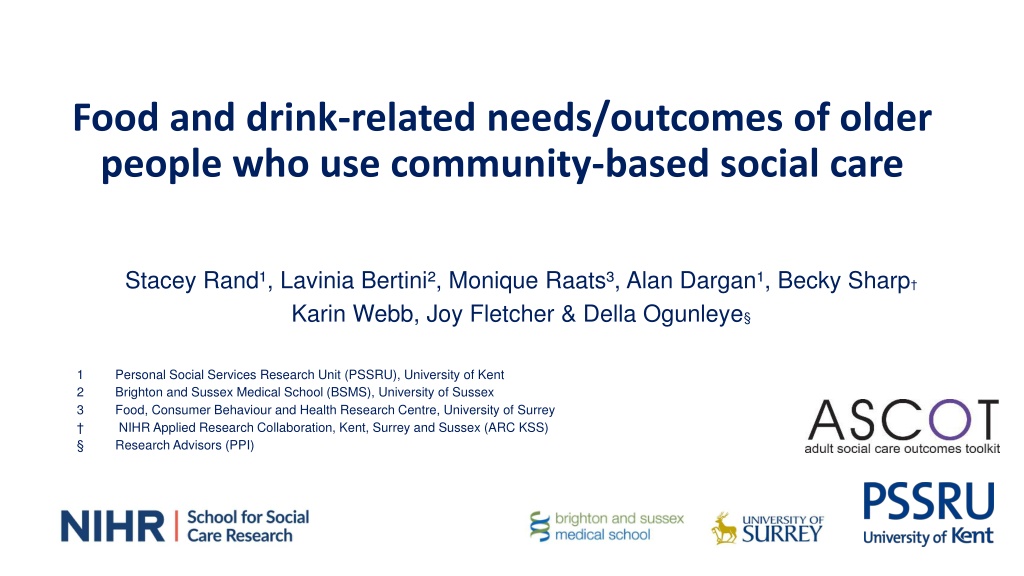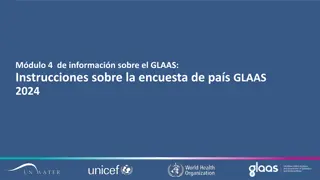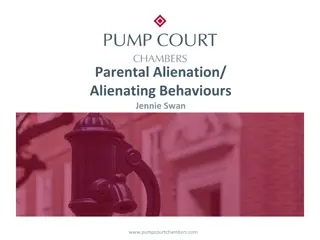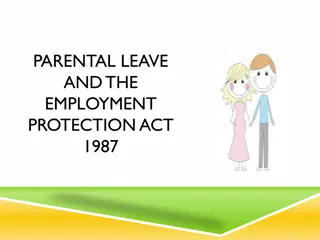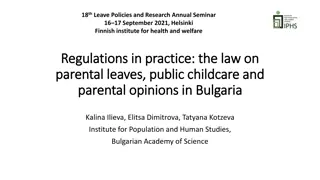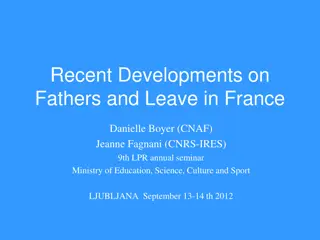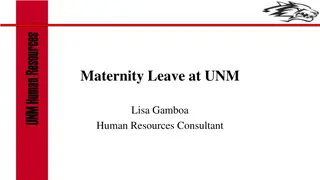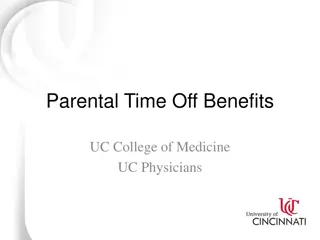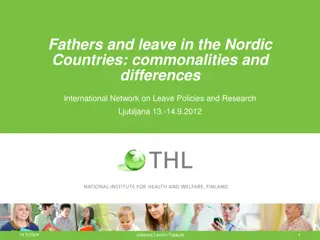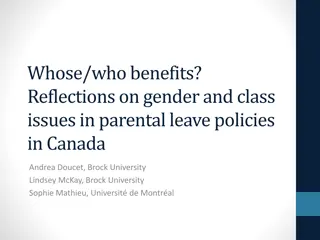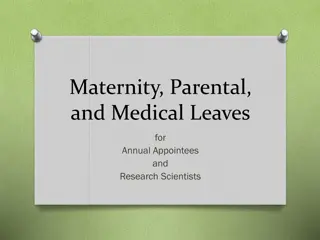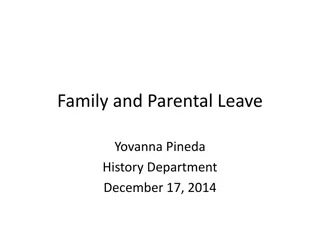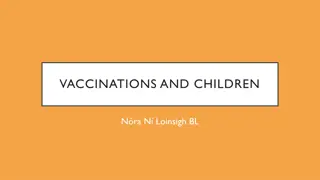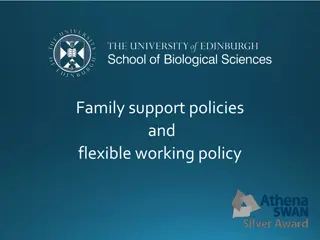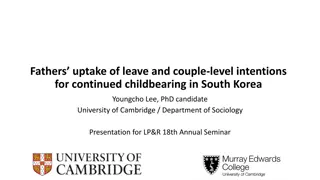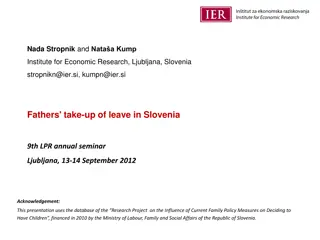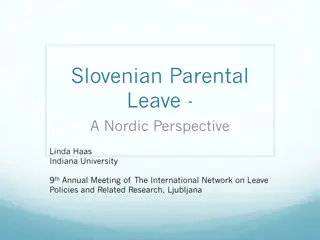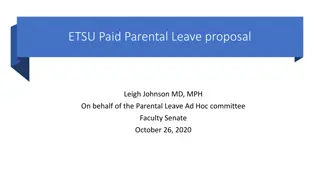Insights from Parental Leave Survey Analysis
Parental Leave Survey conducted by Dr. Elaine Griffiths, RCSEd reveals data on parental leave trends, duration post-natal leave, impact on careers, available resources for planning, and prenatal concerns like clinical competence and CPD. The survey covers responses from 1225 participants aged 31-50 across various specialties and grades, shedding light on male parental leave patterns and knowledge gaps regarding resources.
Download Presentation

Please find below an Image/Link to download the presentation.
The content on the website is provided AS IS for your information and personal use only. It may not be sold, licensed, or shared on other websites without obtaining consent from the author.If you encounter any issues during the download, it is possible that the publisher has removed the file from their server.
You are allowed to download the files provided on this website for personal or commercial use, subject to the condition that they are used lawfully. All files are the property of their respective owners.
The content on the website is provided AS IS for your information and personal use only. It may not be sold, licensed, or shared on other websites without obtaining consent from the author.
E N D
Presentation Transcript
Food and drink-related needs/outcomes of older people who use community-based social care Stacey Rand , Lavinia Bertini , Monique Raats , Alan Dargan , Becky Sharp Karin Webb, Joy Fletcher & Della Ogunleye 1 2 3 Personal Social Services Research Unit (PSSRU), University of Kent Brighton and Sussex Medical School (BSMS), University of Sussex Food, Consumer Behaviour and Health Research Centre, University of Surrey NIHR Applied Research Collaboration, Kent, Surrey and Sussex (ARC KSS) Research Advisors (PPI)
Acknowledgements This presentation summarises independent research funded by the National Institute for Health and Care Research School for Social Care Research (NIHR SSCR). The views expressed are those of the authors and not necessarily those of the NIHR SSCR, the NIHR or the Department of Health and Social Care. Images are from the Centre for Better Ageing s library of age-positive images. Further information about ASCOT is available here: www.pssru.ac.uk/ascot
Background An estimated 1.3 million UK older adults, aged 65+, are undernourished Malnutrition and dehydration are major causes of health deterioration People using community social care (incl. homecare) are at particular risk Complex inter-related risk factors: Health and care-related needs (e.g. limited mobility, cognitive impairment, changes to taste or appetite) Social isolation and loneliness including impact of bereavement Accessibility of local area, including transport to/from shops Low or reduced household income Also, how do we understand food and drink-related needs/outcomes ? Thinking beyond (risk of) dehydration and malnutrition to consider quality of life What role do community-based services play in addressing needs/improving outcomes?
Aims and Objectives To scope existing evidence on food and drink-related needs/outcomes* of older adults using homecare To identify unmet need/outcomes related to Food and drink among older adults using publicly-funded services in England To understand the factors related to unmet need and outcomes * Defined broadly, as food and drink care-related quality of life
Methods 1. Scoping literature review 2. Analysis of the Adult Social Care Survey (ASCS) in England data 3. Developing a guide to findings and recommendations
Work Package (WP) 1 - Scoping Literature Review Objectives Conduct a systematic search of published works and grey literature To gain an overview of the international literature on food and drink-related needs and outcomes of older adults using homecare Establish the type and range of methods, measures and theoretical frameworks applied Identify the conceptual understanding(s) of food and drink-related needs/outcomes Identify evidence of effectiveness of direct care, service delivery or policy interventions where are the gaps? Identify implications for policy and practice
Work Package (WP) 1 - Scoping Literature Review Eligibility criteria: Published journal articles or grey literature that report a research study (or studies) Relates to: Older adults, aged 65 or over, using homecare Food and drink-related needs or outcomes, including: nutrition, hydration and/or quality of life Published in English language, after 2000
Progress so far: Database searches (Nov 2022) Web of Science Psycinfo SCIE Online ProQuest Politics Collection Screening by title/abstract (Dec 2022 to Feb 2023) Review of full-text (Feb-Mar 2023) Summary of each item ( charting ) Qualitative analysis (In progress) Managed in Nvivo Thematic analysis using framework approach
WP2 - Analysis of Adult Social Care Survey Dataset Annual survey of adults using publicly-funded social care services in England Adult Social Care Outcomes Toolkit (ASCOT) to collect care-related QoL data
food & drink care-related quality of life Based on capability approach (i.e. the ability to do and be, as you wish ) = Ideal state = No needs = Some needs = High-level needs Needs met Unmet needs
WP2 - Analysis of Adult Social Care Survey Dataset Preliminary descriptive analysis 12.00% ---- % unmet need (with formal help to eat & drink) 10.00% ___ % overall unmet need 8.00% ___% unmet need (no formal help to eat & drink) 6.00% 4.00% 2.00% 0.00% 2011 2012 2013 2014 2015 2016 2017 2018 2019 2020 2021 2022
WP2 - Analysis of Adult Social Care Survey Dataset What are the factors* related to unmet need? Ethnicity Sex/gender Health and care needs (difficulty with everyday activities, anxiety & depression) Informal help from family & friends Suitability of home design Financial contribution towards cost of care By the person, their family or person & family (combined) Survey year Type of local authority *These are limited by data available in the ASCS dataset or linked data.
B SE OR .891 1.160 Gender: male Ethnicity: categories other than white Local authority Unitary Shire county Inner London Outer London I/ADLs with difficulty Eating and drinking with difficulty Suitability of home Meets most needs Meets some needs Totally inappropriate Informal care / Practical help Outside home Inside and outside home None Privately purchased care ( top up ) Yes, family money Yes, own & family money None Response by proxy report -.115*** .148*** .021 .030 Preliminary analysis . Analysis is still ongoing -.014 -.052 .026 .027 .034 .030 .005 .025 .986 .949 1.224 1.085 1.128 1.646 .202*** .082** .121*** .498*** .657*** 1.429*** 1.842*** .024 .026 .040 1.929 4.176 6.310 Base category Local authority - metropolitan Suitability of home - meets all needs Informal care - inside home Privately purchased care - own money 1.347*** .286*** 1.665*** .027 .047 .033 3.845 1.332 5.283 -.047 .078 .038 .058 .020 .030 .954 1.081 .849 1.101 ** p<0.01 *** p<0.001 -.164*** .096**
B SE OR Survey year 2012 2013 2014 2015 2016 2017 2018 2019 2020 2021 2022 Constant McFadden s pseudo r 2 .008 .025 .036 .047 .046 .046 .044 .044 .044 .046 .045 .046 .107 .044 .053 1.008 1.025 1.037 1.146 1.196 1.221 1.196 1.238 1.259 1.084 1.567 .005 12.0% .136** .179*** .199*** .179*** .213*** .230*** .080 .449*** -5.300*** Base category Survey year (2011) ** p<0.01 *** p<0.001 12,366, df = 29, p<.001
WP2 - Analysis of Adult Social Care Survey Dataset Food and drink care-related QoL ( outcome ) = care intensity + care quality + functional care needs + individual characteristics ASCS dataset does not include individual-level care intensity Estimate of average care intensity per older person using services per LA From 2015 to 2022 only, due to data availability Results are similar except . Ethnicity no longer significant Privately purchased care - with own and family money significant (higher likelihood of unmet need) Survey year, 2021 significant (lower likelihood of unmet need) * Survey year, 2022 significant (higher likelihood of unmet need) Average care intensity per person, by LA - significant (lower likelihood of unmet need) * Survey conducted on a voluntary basis vs mandatory, due to the pandemic.
Summary and Conclusions Estimated 4% to 8% of older adults living at home using community-based social care have unmet food and drink care-related needs % increased between 2011 and 2022 Factors related to unmet need . After controlling for other factors (including average care intensity per person per LA), survey year is significant Does this reflect wider sector impacts (e.g. workforce shortages, chronic underfunding) or context (e.g. pandemic, cost of living increases)? Further analysis Data linkage but a challenge with current data collection and reporting New possibilities based on changes to social care data collection in England ?
WP3 Brief guide to key findings and Recommendations Development, Dissemination and Implementation Share preliminary findings from WP1/2 with the ARC KSS Homecare Community of Experience (June 2023) and other networks: Identify the different audiences and key stakeholders and reason for interest Explore how the findings could be used to inform, engage, influence Development of a brief guide - summarising key findings and recommendations, tailored to the different audiences Consider contextual issues, in relation to implementation Facilitate discussion and commitment to further research Blog post(s) Informed by the Knowledge Exchange, Impact and Engagement (KEIE) Plan Final guide hosted on PSSRU website On-line event (spring 2024)
Any questions? s.e.rand@kent.ac.uk @DrStaceyRand
